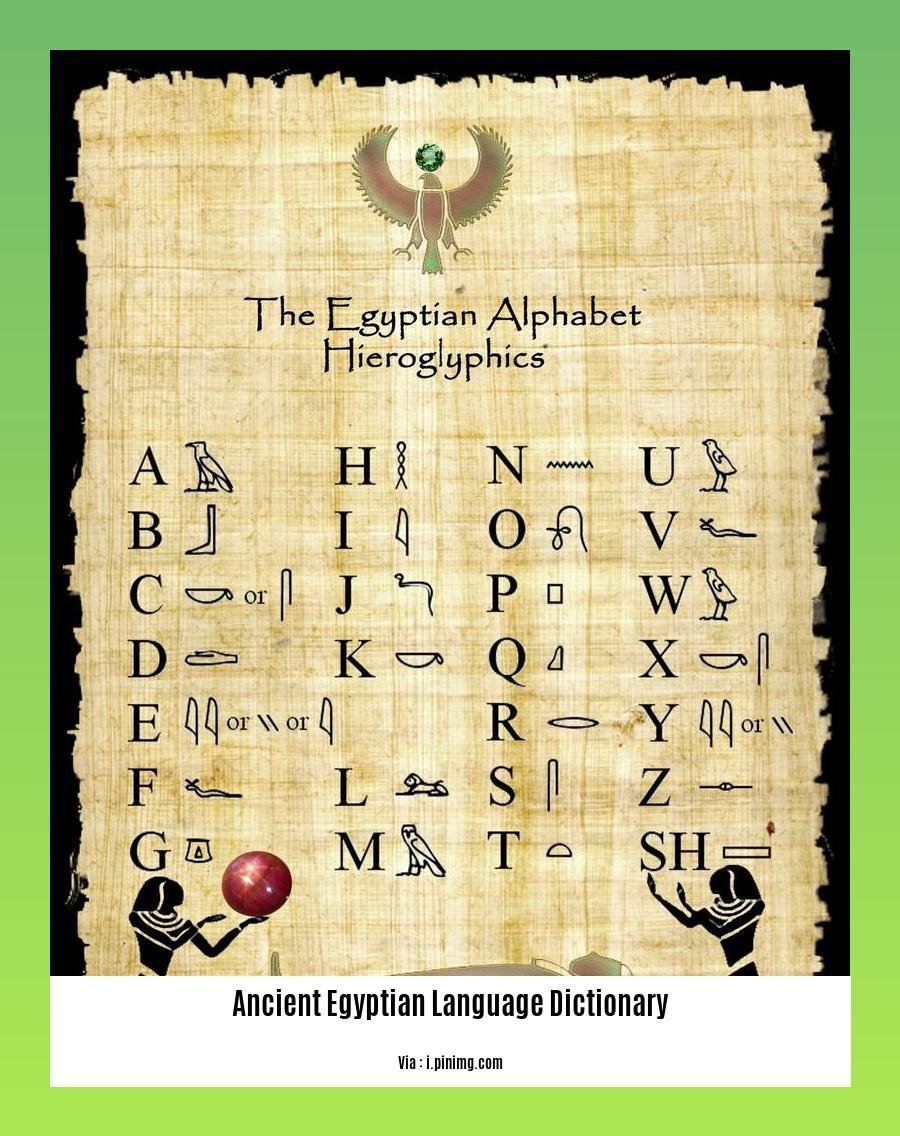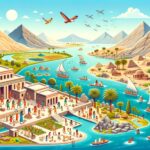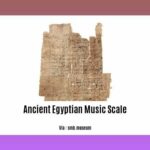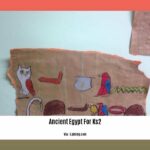Step into the fascinating world of ancient Egypt and unveil the secrets of its written language with [- The Ancient Egyptian Language Dictionary: Unlocking a World of Hieroglyphs and Hieratic Script]. This comprehensive guide will take you on a journey through the hieroglyphs and hieratic scripts, providing profound insights into the rich culture, history, and literature of this ancient civilization. Prepare to decipher ancient texts, unravel the mysteries of the pyramids, and uncover the stories of pharaohs, gods, and everyday people through the lens of their own written words.
Key Takeaways:
Hieroglyphs employed a unique writing system in ancient Egypt for over three millennia.
The term “hieroglyph” stems from Greek and translates to “sacred carving,” signifying its significance in ancient Egyptian culture.
Temples, tombs, and everyday items alike were adorned with hieroglyphs.
The Rosetta Stone served as a crucial catalyst for deciphering hieroglyphs due to its multilingual inscription.
Numerous dictionaries assist learners in comprehending and writing hieroglyphs, such as the Thesaurus Linguae Aegyptiae.
Ancient Egyptian Language Dictionary: Deciphering Hieroglyphs and Hieratic Script
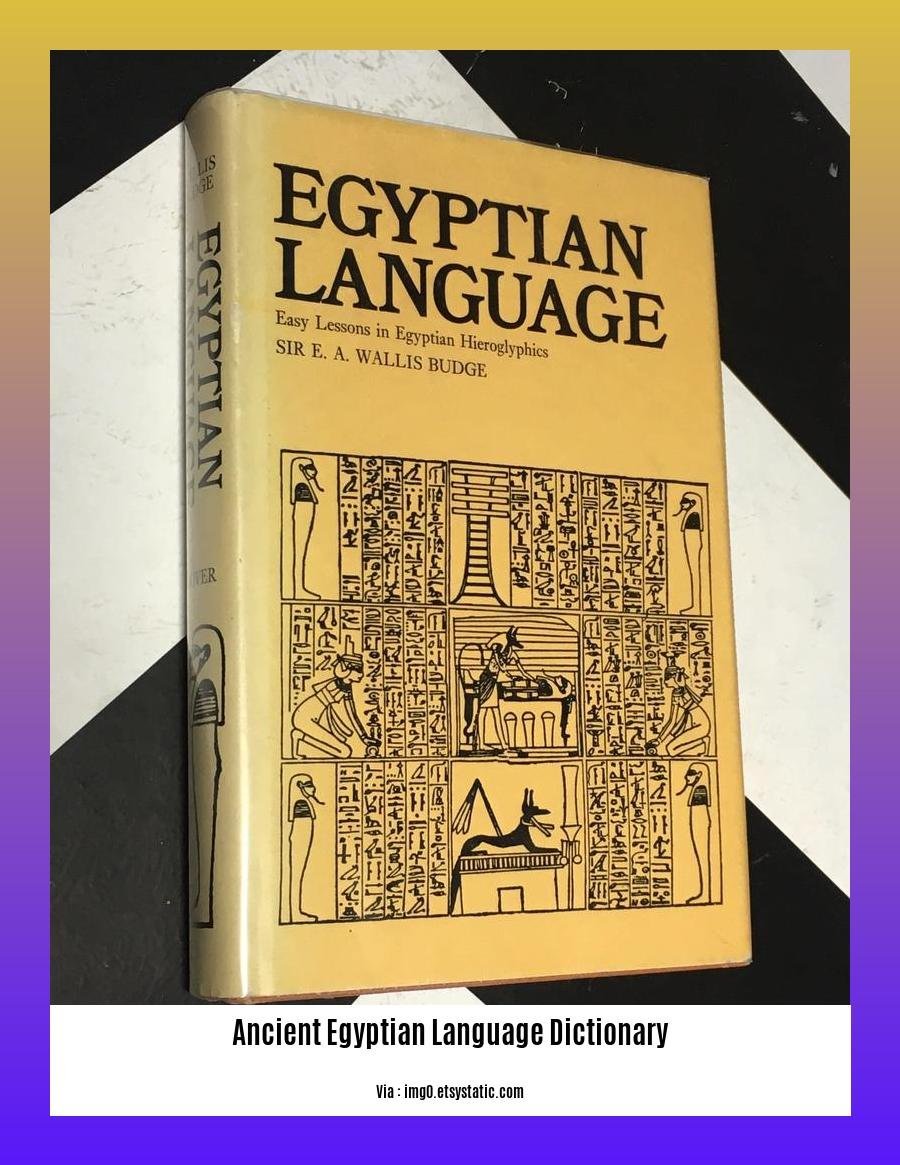
Imagine delving into the captivating world of ancient Egypt, where hieroglyphs and hieratic scripts adorned temples, tombs, and papyrus scrolls. Unraveling the secrets of this enigmatic language is akin to unlocking a treasure chest filled with knowledge, history, and cultural significance. In this article, we embark on a journey to explore the ancient Egyptian language dictionary, a gateway to understanding the written traditions of this extraordinary civilization.
A Glimpse into the Past: The Origins of the Ancient Egyptian Language
In the fertile lands along the Nile River, the ancient Egyptian language emerged as a powerful tool of communication and expression. Its roots can be traced back to the early hieroglyphic inscriptions found in predynastic Egypt around 3000 BC. Over time, the language underwent significant changes, evolving into distinct forms such as Middle Egyptian and Late Egyptian. These variations reflect the dynamic nature of a language that served as the backbone of Egyptian society for over three millennia.
Hieroglyphs: The Sacred Script of the Pharaohs
Among the most iconic aspects of ancient Egyptian culture are the intricate hieroglyphs that adorned monuments, temples, and artifacts. These pictographic and alphabetic characters formed a complex writing system used for religious texts, royal edicts, and funerary inscriptions. The hieroglyphic script, with its elaborate symbols and artistic flourishes, often carried deep religious and symbolic meanings.
Hieratic Script: The Practical Handwriting of Everyday Life
In contrast to the formal and ceremonial nature of hieroglyphs, the hieratic script emerged as a more cursive and simplified form of writing. Primarily used for administrative documents, literary works, and scientific texts, hieratic script allowed for faster and more efficient writing. Its flowing lines and abbreviated characters made it ideal for everyday communication and record-keeping.
Demotic Script: A Simplified Form for the Masses
During the Late Period of ancient Egypt, a further evolution of the written language led to the development of the demotic script. Demotic, with its even more simplified characters, became the dominant script for everyday use, facilitating communication among the general population. Its widespread adoption reflected the growing literacy rates and the need for a practical writing system that transcended the boundaries of social class.
Coptic Script: The Final Chapter in the Evolution of the Ancient Egyptian Language
The Coptic script, the final stage in the evolution of the ancient Egyptian language, emerged during the early centuries of the Common Era. This script, derived from the demotic script, utilized Greek characters augmented with a few additional letters to represent uniquely Egyptian sounds. Coptic served as the liturgical language of the Coptic Orthodox Church and remained in use well into the Islamic period.
The Rosetta Stone: A Key to Unraveling the Ancient Egyptian Language
In 1799, the discovery of the Rosetta Stone, a stele inscribed with identical texts in hieroglyphs, demotic, and Greek, proved pivotal in deciphering the ancient Egyptian language. This remarkable artifact provided scholars with a crucial key to unlocking the mysteries of the hieroglyphic script, paving the way for a deeper understanding of ancient Egyptian history and culture.
The Legacy of the Ancient Egyptian Language
The ancient Egyptian language dictionary stands as a testament to the enduring legacy of a civilization that left an indelible mark on human history. Its written traditions, preserved on papyrus scrolls, stelae, and temple walls, offer invaluable insights into the lives, beliefs, and achievements of the ancient Egyptians. From the sacred hymns of the Book of the Dead to the practical instructions of medical papyri, the ancient Egyptian language dictionary unlocks a world of knowledge and wisdom that continues to captivate and inspire us today.
Not much is known about the ancient Egyptian city planning, but for those curious about their existence, here’s a page dedicated to the ancient Egyptian city planning.
Have you ever heard of the ancient Egyptian music scale? Immerse yourself in the ancient Egyptian music scale to learn more about the intriguing musical system used by the ancient Egyptians.
Looking for an ancient Egyptian name for your story or role-playing game? This ancient Egyptian name generator will provide you with authentic and historically accurate Egyptian names.
Writing Systems Used by the Ancient Egyptians
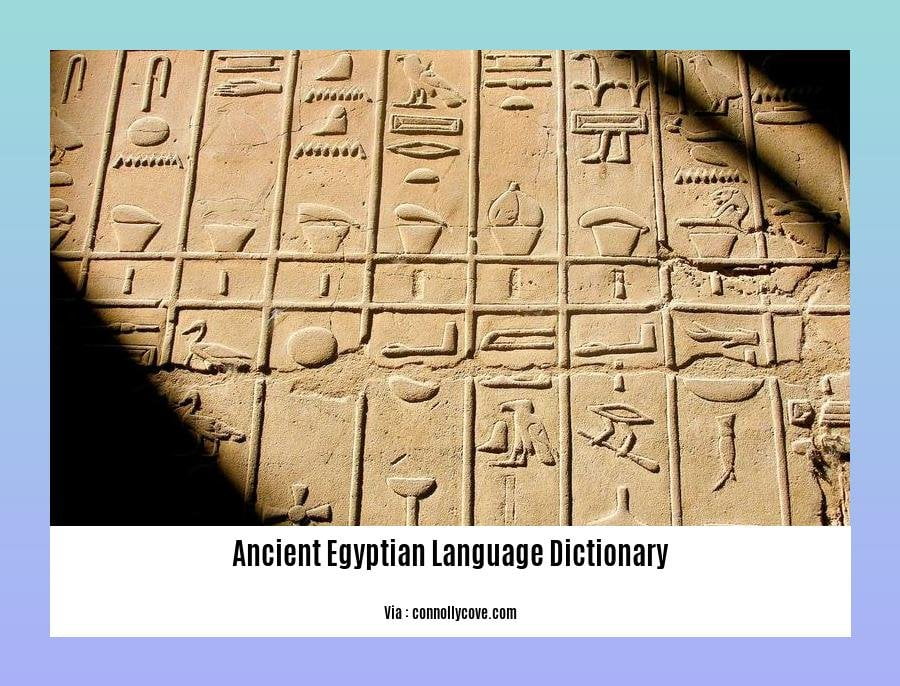
Unraveling the enigmatic writings of ancient Egypt is like embarking on a captivating journey through time. Their hieroglyphs, hieratic, and demotic scripts hold the key to unlocking the secrets of a civilization that flourished for over 3,000 years. Imagine deciphering these ancient symbols, revealing stories of gods, pharaohs, and ordinary people, offering glimpses into their beliefs, rituals, and daily lives. Let’s delve into the captivating realm of ancient Egyptian writing systems:
Key Takeaways:
- Discover the origins and evolution of the Writing Systems Used by the Ancient Egyptians.
- Explore the intricate symbols and scripts that conveyed their rich language.
- Understand the significance of hieroglyphs, hieratic, and demotic scripts in ancient Egyptian society.
- Learn about the Rosetta Stone, the key to unlocking the mysteries of hieroglyphs.
The Enigmatic Hieroglyphs:
Imagine a world where every word is a picture, where symbols dance across temple walls and papyrus scrolls, telling tales of gods and goddesses, of victories and defeats, of everyday life in ancient Egypt. This is the realm of hieroglyphs, the oldest and most elaborate Writing Systems Used by the Ancient Egyptians. These intricate symbols, numbering over 800, were more than just letters; they were art, a visual representation of the Egyptian language.
Hieratic and Demotic: The Scripts of Daily Life:
As time passed, the Egyptians developed two additional scripts, hieratic and demotic, to facilitate everyday writing. Hieratic, a cursive form of hieroglyphs, was more fluid and suited for writing on papyrus. Demotic, an even more simplified script, emerged during the Late Period and became the common script for administrative and business documents.
The Rosetta Stone: Unlocking the Secrets of Hieroglyphs:
In 1799, a remarkable discovery in the Egyptian town of Rosetta changed the course of Egyptology forever. The Rosetta Stone, a stele inscribed with the same decree in hieroglyphs, demotic, and Greek, became the key to unlocking the secrets of hieroglyphs. With Greek as the known language, scholars were finally able to decipher the ancient Egyptian scripts, revealing the rich tapestry of their written heritage.
The Legacy of Ancient Egyptian Writing:
The Writing Systems Used by the Ancient Egyptians played a pivotal role in shaping Western civilization. The Greek alphabet, the foundation of our modern alphabets, evolved from the Egyptian hieroglyphs. The Egyptians’ meticulous record-keeping and literary works provide invaluable insights into their history, culture, and beliefs.
Sources:
Role of the Ancient Egyptian Language in Society and Culture
The ancient Egyptian language was a vital component of society and culture, serving as a tool for communication, governance, religion, and literature.
1. Administration and Record-Keeping:
– The ancient Egyptian language was crucial for administrative purposes, including tax collection, land records, and legal documents.
– Scribes played a vital role in documenting and recording information related to trade, construction projects, and historical events.
2. Literature and Storytelling:
– The ancient Egyptians had a rich literary tradition, which included myths, legends, poetry, and stories.
– Texts like the Pyramid Texts, Book of the Dead, and various literary works provide valuable insights into their beliefs, values, and daily lives.
3. Religious Rituals and Ceremonies:
– The ancient Egyptian language was integral to religious rituals and ceremonies.
– Prayers, hymns, and incantations were written in hieroglyphics and hieratic scripts, and were believed to hold spiritual power.
4. Art and Architecture:
– The ancient Egyptians used their language in art and architecture, with hieroglyphics and other scripts adorning temples, tombs, and monuments.
– Hieroglyphs often served as decorative elements, conveying historical narratives and religious symbolism.
5. Historical Documentation:
– The ancient Egyptian language was used to record historical events, such as military campaigns, royal decrees, and treaties.
– These texts provide valuable insights into the political, social, and economic aspects of ancient Egyptian history.
Key Takeaways:
- The ancient Egyptian language played a significant role in administration and record-keeping, supporting governance and economic activities.
- The language was used in literature and storytelling, preserving myths, legends, and beliefs.
- The ancient Egyptians employed their language in religious rituals and ceremonies, ascribing spiritual power to written words.
- They incorporated their language into art and architecture, using it for decoration and conveying historical and religious narratives.
- The language was used to document historical events, providing insights into various aspects of ancient Egyptian civilization.
Citation:
- The Role of the Ancient Egyptian Language in Preserving Cultural Heritage
- Egyptian Language | History, Writing, & Hieroglyphics | Britannica
Legacy and Preservation of the Ancient Egyptian Language
Key Takeaways:
- Surviving Legacy: The ancient Egyptian language stands as a testament to the rich cultural and written heritage of ancient Egypt, offering invaluable insights into their beliefs, history, and everyday lives.
- Hieroglyphs and Scripts: The hieroglyphic and hieratic scripts were central to this legacy, serving as a means to record religious texts, royal decrees, scientific treatises, and literary works.
- Cultural Exchange: Ancient Egyptian writings facilitated cultural exchange and knowledge transfer with neighboring civilizations, contributing to the development of the written word and early forms of literature.
- Preserving the Legacy: The ancient Egyptian language’s preservation efforts span centuries, including the Rosetta Stone’s crucial role in deciphering hieroglyphs and the ongoing work of scholars to translate and interpret ancient texts.
- Modern Applications: The study of ancient Egyptian language and scripts continues to shed light on the intricacies of ancient Egyptian culture, aiding in the interpretation of artifacts, understanding of ancient beliefs, and appreciation of the enduring legacy of this ancient civilization.
The ancient Egyptians left behind a rich legacy through their written language, which serves as a gateway to understanding their culture, history, and beliefs. The hieroglyphic and hieratic scripts, with their intricate symbols and characters, were the primary means of communication in ancient Egypt. Through these scripts, the ancient Egyptians recorded their religious texts, royal decrees, scientific advancements, and literary works, providing invaluable insights into their worldview and daily lives.
One of the most significant aspects of the ancient Egyptian language’s legacy is its role in cultural exchange and knowledge transfer. The ancient Egyptians interacted with neighboring civilizations, such as the Mesopotamians and the Greeks, and their written language played a crucial role in facilitating cultural exchange and the spread of knowledge.
The preservation of the ancient Egyptian language is an ongoing endeavor that has spanned centuries. The Rosetta Stone, discovered in 1799, proved instrumental in deciphering hieroglyphs, unlocking the secrets of the ancient Egyptian written language. Since then, scholars have dedicated themselves to translating and interpreting ancient texts, bringing to light the rich cultural heritage of ancient Egypt.
In the modern world, the study of the ancient Egyptian language continues to be a vibrant field of research. Scholars use this knowledge to interpret artifacts, understand ancient beliefs, and appreciate the enduring legacy of this ancient civilization. The ancient Egyptian language serves as a reminder of the ingenuity and sophistication of this ancient culture, inspiring awe and admiration in those seeking to explore the mysteries of the past.
Sources:
– The Rosetta Stone and the Decipherment of Egyptian Hieroglyphs
– The Importance of Preserving Ancient Egyptian Language
FAQ
Q1: What is the purpose of an ancient Egyptian language dictionary?
A1: An ancient Egyptian language dictionary provides a comprehensive resource for understanding the vocabulary, grammar, and usage of the ancient Egyptian language, including hieroglyphs and hieratic scripts. It serves as a valuable tool for scholars, researchers, and enthusiasts seeking to decipher and translate ancient Egyptian texts.
Q2: What types of ancient Egyptian dictionaries are available?
A2: There are various types of ancient Egyptian dictionaries available, each focusing on different aspects of the language. Some common types include:
- Hieroglyphic dictionaries: These dictionaries provide a comprehensive listing of hieroglyphic signs, their phonetic values, and their meanings.
- Hieratic dictionaries: These dictionaries focus on the hieratic script, which was a cursive form of hieroglyphs used for everyday writing in ancient Egypt.
- Coptic dictionaries: These dictionaries provide translations and explanations of Coptic words, which is the latest stage of the ancient Egyptian language.
Q3: How can an ancient Egyptian language dictionary help me learn the language?
A3: An ancient Egyptian language dictionary can assist in learning the language by providing:
- Word definitions: The dictionary provides definitions and explanations for ancient Egyptian words, helping you understand their meanings and usage.
- Grammar guidance: Some dictionaries include sections on grammar, providing information on verb conjugations, noun declensions, and sentence structure.
- Examples and citations: Many dictionaries include examples and citations from ancient Egyptian texts, allowing you to see how words were used in context.
Q4: What are some notable ancient Egyptian language dictionaries?
A4: Some notable ancient Egyptian language dictionaries include:
- The Thesaurus Linguae Aegyptiae (TLA): This is a comprehensive dictionary of the ancient Egyptian language, covering all periods and scripts.
- The Concise Dictionary of Middle Egyptian: This dictionary focuses on the Middle Egyptian period and is known for its reliable and up-to-date information.
- The Egyptian Hieroglyphic Dictionary (EHD): This dictionary provides detailed information on hieroglyphic signs, including their phonetic values, meanings, and variations.
Q5: Where can I find more information on ancient Egyptian language dictionaries?
A5: There are various resources available to find more information on ancient Egyptian language dictionaries:
- Online resources: Many websites and online databases provide information on ancient Egyptian dictionaries, including reviews, comparisons, and sample entries.
- Libraries: Public and academic libraries often have a collection of ancient Egyptian language dictionaries that can be accessed for research purposes.
- Bookstores: Specialized bookstores that focus on Egyptology and ancient languages may carry a selection of ancient Egyptian language dictionaries.
- Sept 31 Myth: Unveiling Calendar Secrets - March 18, 2025
- How Long & Till December 18, 2025: Accurate Countdown Guide - March 18, 2025
- Discover Japanese Artists: A Complete History - March 18, 2025
